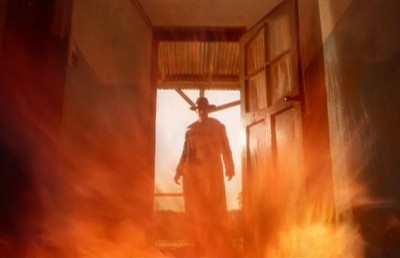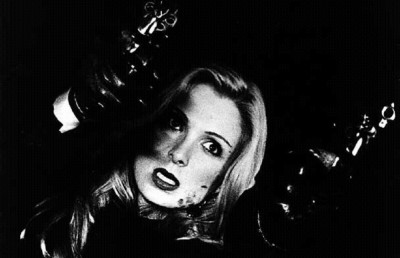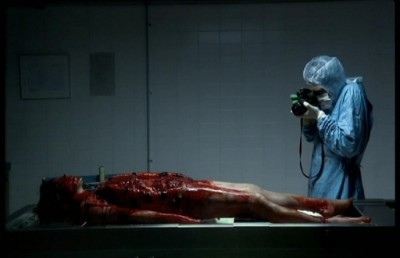Fant-Asia Report 2: A Wrap Up
Cutting Moments
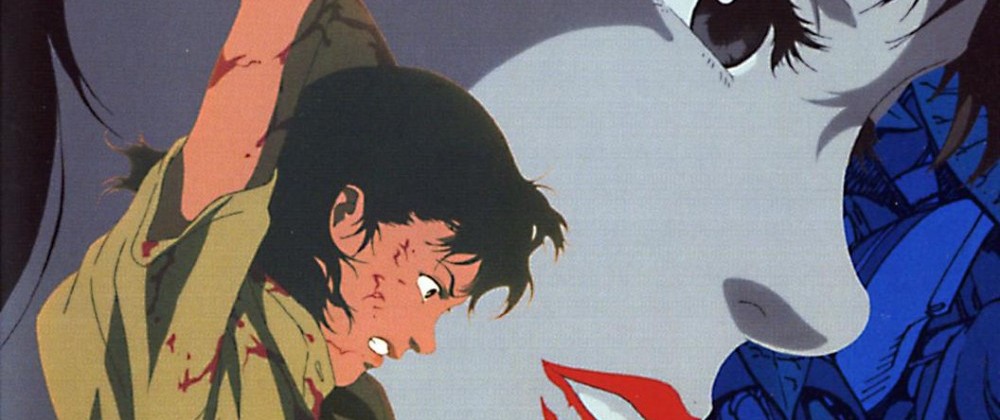
The whirlwind that was Fant-Asia has come and gone, leaving in its wake some 70,000 spectators and a trail of cinematic blood and bullet-ridden body parts. The corner of St.Catherine and Bleury will never be the same, not until next year at least. If Fant-Asia follows this years popular recipe next year it could very well be subtitled: The Cinema of Excess. Without a doubt, “over-the-topness” was the operative word this year, whether it was action ( Drunken Master 2, A Gun for Jennifer, Black Mask ), melodrama ( Lovers ), violence ( Aftermath, Cannibal Ferox ), comedy ( The Sixty Million Dollar Man, The God of Cookery ), gangsterism ( Score, Fudoh ), nihilism ( Red to Kill, Henry 2 ), just plain style ( Love God, Too Many Ways to be Number One, Ashes of Time ), sheer lunacy ( Fatal Frames, Burial Ground ) or sheer intensity ( Charlie’s Family, Cutting Moments)
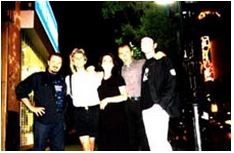
Author Donato, 2nd from left, with Italian entourage, from left, Sergio Stivaletti, Patrizia, Loris Curzi, Mariano Baino
A major difference between this year and last is the added guest list of visiting filmmakers, writers, journalists and critics. The healthy list of invited guests surely cut into the Festival profits, but it helped enormously in creating a buzz and instilling self-confidence among the fest organizers (as well as putting Fant-Asia on the International map). The guests seemed to genuinely enjoy themselves amid the hoopla and fanfare. There seemed to be a constant and symbiotic exchange of energy between Fant-Asia fest regulars, fest organizers, especially Mitch Davis, Karim Hussain and Julien Fonfrède, and the visiting fellow cinephiles, journalists and filmmakers. Guests included Michael Gingold from Fangoria magazine, Mr. Deep Red/ Gore Score himself Chas. Balun, Glen Wilcox and Alex Ojeda from Graveside Entertainment & Blackest Heart Media , Spanish director Nacho Cerdà, American Grit-Indie director Jim Van Bebber, Troma’s Lloyd Kaufman and James Gunn, the Italian entourage of director Sergio Stivaletti, writer-publicist Loris Curci and (Italo-Brit) director of Dark Waters Mariano Baino (winner of the most intriguing accent award) and the indefatigable Brit-pack of writer-journalists Harvey Fenton ( Flesh and Blood ), Jason Slater ( Diabolik, Shivers ), Martin Coxhead ( Dark Side ), Marcelle Perks ( Shivers, BBC World ) and director Richard Stanley. On the day when a large chunk of the guests left at once there was a genuine sense of sadness and a gaping void was felt over the next few days.
But of course the heart of any film festival is the programming, and this year’s selection offered treats wild and eccentric enough to please the most varied palette’s. For knock-down-the-doors popularity Jackie Chan’s amazing Drunken Master 2 and mediocre (for Jackie anyway) Operation Condor and the Japanimation Perfect Blue were the undisputed victors (though there were 25 sell-outs in all). True anime aficionados may have been disappointed with the work-in-progress version of Perfect Blue , specifically because the film feels like it could have played equally well as a live-action film. But it’s not the form but rather the narrative that makes it a refreshing anime. The narrative is an ambitious giallo-thriller that may not work seamlessly but breaks new ground as an anime psychological horror thriller. Several of the film’s murder set-pieces recall the Italian giallo thriller, especially Dario Argento’s Deep Red and Tenebrae The film is a spiraling riff on the doppelganger theme. A fading pop star Mima, is forced by her producers to become a television actress in a show appropriately entitled “Double Bind.” Mima has trouble adjusting to her new identity and begins to hallucinate an alter ego. The film slowly breaks down into a quagmire of ontological uncertainty as Mima the unhappy actress begins to imagine her former Mima pop star self as a phantom spectre, who may or may not be causing Mima, or Mima’s all-too faithful fan (“Mimaniac”) to perform a series of brutal murders. The doppelganger theme is fleshed out nicely in the visual style, with constant use of reflecting surfaces, repeating scenes/shots and a verging-on-parodic use of the dream within a dream structure.
Perfect Blue feels like a cross between The Fan and Poe’s William Wilson . The film may in fact be richer in its subtext than text, recalling French theorist Jean Baudrillard’s “simulacrum” where image and illusion become as real as the real. As the film progresses we join Mima in the inability to distinguish between the real and the imagined. The idea of a simulacrum plays even stronger within Japan’s image-laden culture. The film can be also read as a metaphor on the pressures of celebrity status. Mima’s “career” is so strongly shaped by her producers, agents and fans that she no longer has a sense of identity. Everywhere she looks, from the posters on her wall, her television screen, to her computer moniter, she encounters another self.

Mima from Perfect Blue
For Fant-Asia fans with a slightly more refined taste (dare I say the intelligentsia), Ashes of Time and Too Many Ways to be Number One were fest highlights. Ashes of Time is a contemplative action film (if you could imagine that!) with a who’s who of Hong Kong stars (Leslie Cheung, Tony Leung Kar-fai, Brigitte Lin, Tony Leung Chiu-wai, Maggie Cheung, Jacky Cheung) that ultimately showcases cinema’s innate ability to deconstruct temporality and narrative order. Whereas Perfect Blue consciously plays with dream states, Ashes of Time sucks the spectator into its languid, ethereal spiral without recourse to the obvious cues. The former is structured around dreams, the latter IS a dream. Too Many Ways to be Number One is Wai Kar-fai’s simultaneous tribute and satire to the Hong Kong action crime film. More directly, the recent triad genre films which concentrate on contemporary urban brutality and machismo rather than the sins of the medieval past. One hopes that films like Too Many Ways and Once Upon a Time in Triad Society are signs for the future of Hong Kong cinema rather than a post-classical end phase.
Another possible direction the Honk Kong action film may take is represented by Black Mask . Though Black Mask has far more style than almost any of its American counterparts, it does move closer in execution to an American brand of action. With the Chinese takeover of Hong Kong and the exodus of directors/stars to the West, Black Mask may foreshadow the action film of the future: a compromise between the grace, poetry and fantasy of Hong Kong style and the more serious, realist-based American style. This is clearly evidenced in how Black Mask relies much more on an American-style fragmented fight choreography (through quick cutting and angle changes) than the Hong Kong approach where body movements are kept more intact. The Tsui Hark produced film, which features fest-favorite Jet Li in a rare non-period piece role, is still a very entertaining film. Unfortunately, Li’s role, partially hidden behind a mask and somewhat smothered by the film’s high-budget effects, is not the breakthrough (to the U.S. market) Jet Li showcase piece it might have been.
Jet Li plays a member of the 701 squadron, an elite group assassins who have been de-sensitized to pain through brain surgery. The operation has made them near-invincible killing machines, but in the case of Jet Li, has also left them yearning to “be human” and have true “feelings” once again (recalling in a twisted way, the “senseless” angels from Wenders’ Wings of Desire and the replicants from Blade Runner ). After an incredible action-packed pre-credit sequence, we see Jet Li assuming the role of a timid librarian in an effort to settle into a normal life (interestingly, the angels in Wings of Desire use a library as their “headquarters”). However, Jet Li is soon drawn into the role of masked super hero crime fighter by night when he discovers that the 701 squadron is together again trying to take over the Hong Kong drug cartel. Li’s on-screen presence is matched if not surpassed by super cop Lau-Ching-wan, with whom he teams up to overcome the 701 squadron. Li’s character obviously recalls Bruce Lee’s Green Hornet, but the film’s visual look is reminiscent of The Crow (the black clad, long-haired evil druglord who leads the 701 squadron is also modeled on Ernie Hudson’s [more effective] villain in The Crow).
Black Mask would have played nicely alongside The Assassin , as its modern counterpart. In the period piece The Assassin (which contains one of the best eye-sewing scenes ever!) enemies of the Emperor are captured and “trained” to become ruthless killers in the service of the Emperor. In both Black Mask and The Assassin an assassin is steered back onto the moral road through love and virtue.
Black Mask still looks like a gem when seen alongside the usual American equivalent. Just compare the Black Mask ‘s pre-credit sequence to that of Spawn ‘s, a film which shares a few similarities with Black Mask (trained super assassins, good/bad assassins, despots). Both scenes feature an assassination, but in Spawn there is a greater reliance on high-tech weaponry and special visual effects than Black Mask and is filmed in a far more conventional manner. Spawn is another millennium-angst film, where hell, purgatory and earth exist side-by-side, with the apocalypse just around the corner. Martin Sheen seems to be playing an extension of his Dead Zone character, though here he is less convincing as the despot willing to trigger the apocalypse. Similarly to Jet Li in Black Mask , the hero Michael J.White plays 95% of his role behind either burnt face makeup or a mask. This is unfortunate, given that the Spawn is an (rare) African-American super-hero. Having his face hidden for most of the film pretty much negates his identity as an African-American and whatever socio-political value the original comic book may have had.
Spawn boasts some good art direction, an excellent credit sequence and a genuinely grotesque villain in the Clown (played by with appropriate ham by the diminutive John Leguizamo). However, it is ultimately dragged down by a weak, derivative script and an over reliance on digital effects. Some of the digital effects are good, like those enhancing the Spawn character, but there are too many scenes that rely exclusively on CGI (such as the scenes in hell). And can anyone explain that purgatory-like space? Couldn’t they come up with something more threatening or visually inventive than a slum area! Spawn is one of the few films that doesn’t measure up to Fant-Asia’s quota of cinematic excess.
Jet Li fans may not have seen as much of Li as they wanted in Black Mask , but they were accorded a special treat when Fant-Asia screened the young 18 year-old Jet Li’s very first screen performance in The Shaolin Temple . The most amazing thing about the first screening of The Shaolin Temple was that even though the print had no subtitles, very few of the sell-out crowd walked out or complained!
By far, the most offensive film at Fant-Asia was the violent rape fantasy film Red to Kill . It’s hard to get a handle on what director Billy Tang was trying to accomplish with Red to Kill because of the uncomfortable ease with which the film goes from Woo-like over-sentimentality to really grim violence. Violence, even at extreme measures, can usually be rationalized within the horror genre, but the way director Tang eroticizes rape is inexcusable and exemplifies exploitation at its ugly worse (especially when he does it twice, which no one can justify by any measure). I guess credit should be given to Ben Ng for his histrionic performance as the good looking, muscular serial killer who goes kill-crazy when he sees red. Ng goes through the performance with more ticks than a mangy dog. The crazier he becomes, the wilder his performance, until he appears in the final rape-battle scene, bald, in skin tight wrestling uniform transformed into a human-size phallus, hopping around like a bull in a China shop.
The film’s final sequence had the midnight audience incredulously laughing at the inane way that Tang ends such an at times horrifying film. The scene takes place in a hospital room with the injured mentally deficient heroine Ming Ming laying unconscious, perilously close to death after a vicious, drawn out battle with the demented serial killer. She is surrounded by her partner in battle, her sister, and the other mental patients who live in the same Hong Kong slum building. The group tries hard to revive Ming. One of the mental patients shows Ming her fish bowl, and tells her that she must awaken to feed the fish. Ming’s eye twitches a sign of life. Hope seems eternal. The mentally challenged group begin to grimace wildly and happily. Gloom and doom slips back into the picture when the fish bowl crashes to the floor in slow motion, sending the fish twitching to their symbolic death. The scene cuts to the final overhead angle shot of the mental patients absurdly jumping up and down in a collective dance of sorrow. The shot ends in a freeze frame. The audience I was with didn’t know what to think! Many of us left the theatre shaking our heads, trying to decide to what level Tang was conscious of this wild melodramatic shift. Is he really pulling our collective legs or is he just a sick fuck?
One of the most gut-wrenching scenes in Red to Kill is the one where Ming Ming takes a shower to cleanse her body and soul after being raped. After washing herself Ming takes a straight razor and begins to shave her genital hair. As she repeats the words “dirty, dirty” her hand thrusts become quicker and more violent and blood begins to mix with falling pubic hair. Though not fatal, the self-mutilation that caps this excruciating scene recalls the climax of Cutting Moments , a film which gets my vote for most harrowing film experience at Fant-Asia 1997 (some may argue for the remarkable Aftermath but I cling to Cutting Moments because it is couched in a more human, real and believable context).
At only 30 minutes, Cutting Moments packs a real emotional wallop and is the final word on dysfunctional marriages. The film is methodical in the way it builds slowly to its bloody climax. We witness the non-communication between a middle class family, wife, husband and young son. Nothing the wife does moves the husband beyond a stern, cold stare. Something has obviously happened to this once happy marriage and an emotional chasm now exists between the husband and wife big enough to fit the Arctic. The wife has one final whack at the emotional wall separating her and her husband. While the husband sits stoically watching a baseball game on television (the all-American game), the wife is in the washroom, wearing a sexy dress, fixing her hair, and applying makeup. All we hear is the sound of the baseball broadcast, a constant reminder of the husband and pure Americana. She walks out to the living room and stands in front of the husband, hoping to seduce him away from the baseball game. All she gets is a slow, chilled look. Dejected, the wife returns to the bathroom, and the domestic horror begins. She looks into the mirror, hating what she sees and what the marriage has become. The camera frames her mirrored reflection. She paints a lipstick grin on the mirror which hides her real sad mouth, giving her the appearance of a clown. She grasps a cleaning brush from the wastebasket and begins to rub it left to right across her mouth. As her strokes become more violent, pieces of flesh fall into the basin. Next comes the shot the audience has dreaded: of scissors sitting in a glass on the basin. She reaches for them and there is now no escape from her descent into self-mutilation.
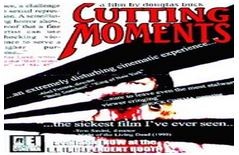
Every now and then director Douglas Buck re-sensitizes us to the horror by cutting to the husband perched on the couch, oblivious to the horror he is complicit in. The special effects, supervised by the great Tom Savini (who doesn’t get many opportunities these days for such visceral violence), are too believable. The wife begins to cut at her upper and then lower lip (I’m actually feeling queasy as I recall the scene and right this). Overhead shots give a grim vantage of bits of bloodied flesh falling into the basin and onto her bosom. The wife lumbers back to the living room. Only now, her mouth a gaping wound, does the husband show any emotion. The film should have ended here. Instead it goes one scene further into anti-climax. Still, a powerful piece of reality-based horror.
Cutting Moments played before Henry 2 , which gets my vote for the most nihilistic double-bill at Fant-Asia. Rich Komenich, who plays Henry’s sidekick Kai, gave a brief but enthusiastic introduction which primed the audience for Henry 2. Henry 2 is a sequel which at times feels like a remake (which isn’t meant as a criticism). Several scenes, character relations and set-pieces recall the original Henry , but there is enough to set this off as its own effective take on the serial killer. Director Chuck Parello does an excellent job introducing new characters (the mentally troubled sister for example) while continuing along in John McNaughton’s non-judgemental, realist style. Like McNaughton, Parello spares us psychological explanations or moral payback. Parello’s vision, bloodier and more violent, is as grim here as in the original. They kill and we witness. It’s as simple as that. Neil Giuntoli as Henry 2 lacks Michael Rooker’s quiet inner calm, but has an effective screen presence and teams up nicely with Rich Komenich as Kai. Kai is not the moron that Otis was in the original, which makes his eventual subservience to Henry reminiscent of the relationship between master and slave in the Joseph Losey/ Harold Pinter film The Servant . Only in this case, Kai’s much larger physical size substitutes for class superiority.
I could go on ranting about other films, like the soon-to-be camp classic Fatal Frames , or the mesmerizing Charlie’s Family , or the innovative Fudoh , or the chamber-styled horror piece Dark Waters , or the crowd-pleasing Gamera 2 , or the “limp” (literally) Tender Flesh , or the nostalgic Wax Mask but, like Fant-Asia, all things must pass. And I’ll pass on the final word to the Fant-Asia voting public. Since Fant-Asia is not a competitive festival -though that may change in the future– there were no official prizes handed out. However, fans did vote for the most popular film in three categories: Asian Film, International Section, and Short Film [all had to post–1992]. (The fact that the word popular prevails over best is indicative of the festival hierarchy’s bias toward mass appeal entertainment. No doubt the coffers would agree with Hollywood Studio mogul Harry Cohn, who said, “If you want a message, call Western Union.”). The winner’s are:
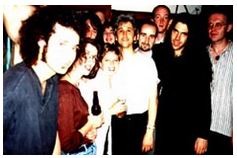
L-R, Karim Hussain, (Jim Van Bebber’s elbow!), Sherri Rickman, Ashley Fester, Donato Totaro, Nacho Cerda, Alex, Mitch Davis, Harvey Fenton
Asian Film: Perfect Blue , with Drunken Master 2 and Ashes of Time as runner-ups.
International Section: A Gun for Jennifer , with Day of the Beast, Charlie’s Family , and Dark Waters in that follow-up order.
Short Film: Aftermath , followed by Dr. Curry and Cutting Moments
.



